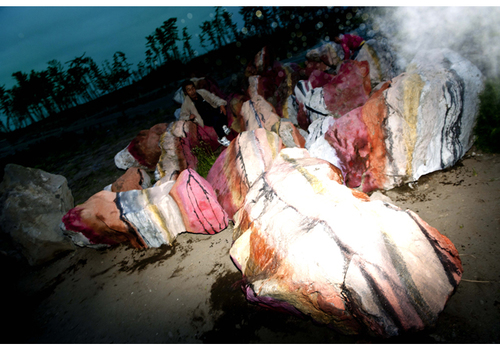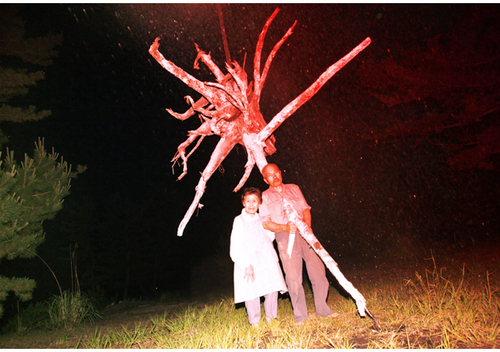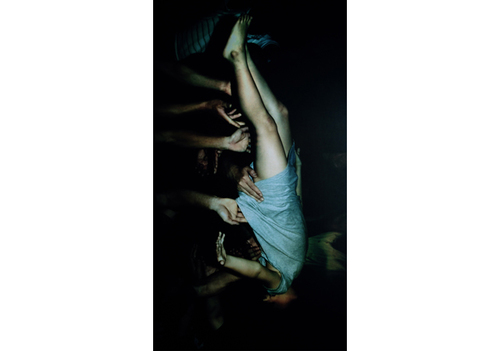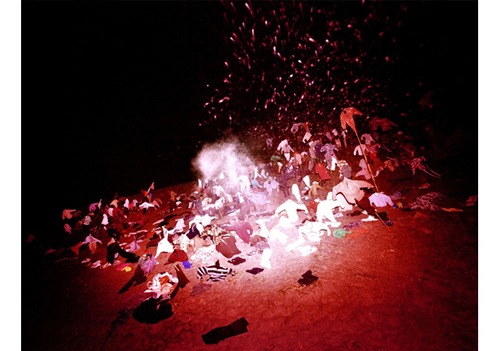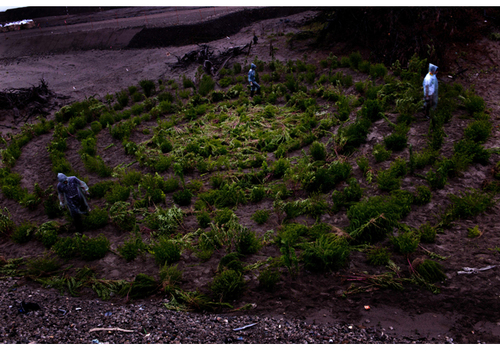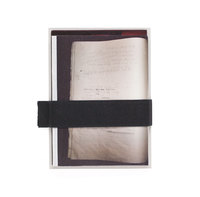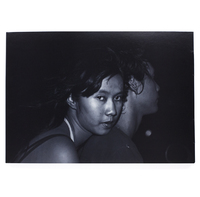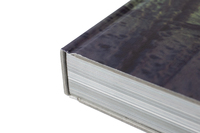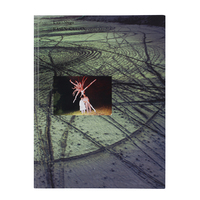Lieko SHIGA
志賀理江子
Chronology
1980 Born in Aichi prefecture, Japan
2004 Graduate at Chelsea University of Art and Design / BA Fine Art New Media, London, UK
2004 Graduate at Chelsea University of Art and Design / BA Fine Art New Media, London, UK
Publications
2007 "Lilly" artbeat Publishers CO, Ltd.
2007 "CANARY" AKAAKA Art Publishing, Inc.
2009 "CANARY-MON" AKAAKA Art Publishing, Inc.
2007 "CANARY" AKAAKA Art Publishing, Inc.
2009 "CANARY-MON" AKAAKA Art Publishing, Inc.
Selected Solo Exhibitions
2001 "Floating Occurrence" graf, Osaka, Japan
2003 "Jaques saw mw tomorrow morning." graf media gm, Osaka, Japan
2005 "Lilly" graf media gm, Osaka, Japan
2006 "Lilly" NUKE gallery, Paris, France
2008 "A Stranding Record" Fotogalleriet, Oslo, Norways
2011 "CANARY" Mitsubishi-Jisho ARTIUM, Fukuoka, Japan
2011 "CANARY" Galerie Priska Pasquer, Cologne, Germany
2012 "RASENKAIGAN" Sendai Mediatheque, Miyagi, Japan
2013 "CANARY" Foam Museum, Amsterdam, Netherlands
2003 "Jaques saw mw tomorrow morning." graf media gm, Osaka, Japan
2005 "Lilly" graf media gm, Osaka, Japan
2006 "Lilly" NUKE gallery, Paris, France
2008 "A Stranding Record" Fotogalleriet, Oslo, Norways
2011 "CANARY" Mitsubishi-Jisho ARTIUM, Fukuoka, Japan
2011 "CANARY" Galerie Priska Pasquer, Cologne, Germany
2012 "RASENKAIGAN" Sendai Mediatheque, Miyagi, Japan
2013 "CANARY" Foam Museum, Amsterdam, Netherlands
Selected Group Exhibitions
2004 "Jacques" (video installation) Yamaguchi center for Arts and Media, Yamaguchi, Japan
2005 "Art Court Frontier 2005" Art Court Gallery, Osaka, Japan
2006 "Temporary Art Museum Soi Sabai" Baan pla dib, Bangkok, Thai
2006 "Stolen Recorder" Areal28, Berlin, Germany
2006 "Rapt! Contemporary art from Japan" Seventh Gallery, Melbourne, Australia
2006 "Re;search, The Art Collaboration with Australia and Japan" Sendai Mediatheque, Sendai, Japan
2007 "BMW Young Asian Artist Series" Tyler Print Institute, Singapore
2008 "Unseen" Museum of Contemporary Art Shanghai, China
2008 "KITA! Japanese Artists meet Indonesia" Jogja National Museum, Yogyakarta, Indonesia
2008 "Kimura Ihei Commemorative Photography Award Show" Konica Minolta Plaza Gallery, Tokyo, Japan
2008 "Trace Elements" Tokyo Opera City Art Gallery, Tokyo, Japan
2008 "On Your Body" Tokyo Metropolitan Photography Museum, Tokyo, Japan
2008 "Singapore Biennale 2008: Wonder" City Hall, Singapore
2009 "Trace Elements" Performance Space, Sydney, Australia
2009 "Twist and Shout: Contemporary Art from Japan" Bangkok Art and Culture Centre, Bangkok, Thai
2009 "Yokohama International Video Festival 2009 CREAM: Creativity for Arts and Media" BankART Studio NYK, Yokohama, Japan
2009 "Takamatsu Contemporary Art Annual vol.00 -Vision of Captured Time-" Takamatsu City Museum of Art, Takamatsu, Japan
2010 "Roppongi Crossing 2010: Can There Be Art? The Creative Potential of a New Japan" Mori Art Museum, Tokyo, Japan
2010 "Move on Asia (Single Channel Video art)" Gallery Loop, Seoul, Republic of Korea
2010 "New York Photo Festival 2010 "Hidden Books, Hidden Stories" Curated by Lou Reed" St. Ann’s Warehouse (South), NewYork, United States of America
2010 "3. International Photobook Festival" documenta-Halle, Kassel, Germany
2010 "Aichi Triennale 2010: Arts and Cities" Aichi Arts Center/Nagoya City Art Museum/the Choja-machi area, Aichi, Japan
2011 "Art Miyagi 2011" The Miyagi Museum of Art, Miyagi, Japan
2011 "ANT!FOTO 2011" Kunstraum Dusseldorf, Dusseldorf, Germany
2011 "CLOSE YOUR EYES AND TELL ME WHAT YOU SEE" Gothenburg Konstmuseum, Gothenburg, Sweden
2011 "Mizu no Oto - Sound of Water:Fotografia-Festival Internazationale di Roma" Roma, Italy
2012 "Visble / Invisible" Toyota Municipal Museum of Art, Aichi, Japan
2012 "Photomonth in Krakow May 2012" Manggha Center of Japanese Art and Technology, Krakow, Poland
2012 "Creating with Light / The Manipulated Photograph" Tokyo Metropolitan Photography Museum, Tokyo, Japan
2012 "Double Vision: Contemporary Art from Japan" Moscow Museum of Modern Art, Moscow, Russia
2013 "ARTIST FILE 2013 -The NACT Annual Show of Contemporary Art" The National Art Center, Tokyo, Japan
2013 "AICHI TRIENNALE 2013" Okazaki CIBICO, Aichi, Japan
2013 "All There Is Left" the Adam Art Gallery, New Zealand
2013 "TOWADA OIRASE ART FESTIVAL" Fisheries rest house, Aomori, Japa
2005 "Art Court Frontier 2005" Art Court Gallery, Osaka, Japan
2006 "Temporary Art Museum Soi Sabai" Baan pla dib, Bangkok, Thai
2006 "Stolen Recorder" Areal28, Berlin, Germany
2006 "Rapt! Contemporary art from Japan" Seventh Gallery, Melbourne, Australia
2006 "Re;search, The Art Collaboration with Australia and Japan" Sendai Mediatheque, Sendai, Japan
2007 "BMW Young Asian Artist Series" Tyler Print Institute, Singapore
2008 "Unseen" Museum of Contemporary Art Shanghai, China
2008 "KITA! Japanese Artists meet Indonesia" Jogja National Museum, Yogyakarta, Indonesia
2008 "Kimura Ihei Commemorative Photography Award Show" Konica Minolta Plaza Gallery, Tokyo, Japan
2008 "Trace Elements" Tokyo Opera City Art Gallery, Tokyo, Japan
2008 "On Your Body" Tokyo Metropolitan Photography Museum, Tokyo, Japan
2008 "Singapore Biennale 2008: Wonder" City Hall, Singapore
2009 "Trace Elements" Performance Space, Sydney, Australia
2009 "Twist and Shout: Contemporary Art from Japan" Bangkok Art and Culture Centre, Bangkok, Thai
2009 "Yokohama International Video Festival 2009 CREAM: Creativity for Arts and Media" BankART Studio NYK, Yokohama, Japan
2009 "Takamatsu Contemporary Art Annual vol.00 -Vision of Captured Time-" Takamatsu City Museum of Art, Takamatsu, Japan
2010 "Roppongi Crossing 2010: Can There Be Art? The Creative Potential of a New Japan" Mori Art Museum, Tokyo, Japan
2010 "Move on Asia (Single Channel Video art)" Gallery Loop, Seoul, Republic of Korea
2010 "New York Photo Festival 2010 "Hidden Books, Hidden Stories" Curated by Lou Reed" St. Ann’s Warehouse (South), NewYork, United States of America
2010 "3. International Photobook Festival" documenta-Halle, Kassel, Germany
2010 "Aichi Triennale 2010: Arts and Cities" Aichi Arts Center/Nagoya City Art Museum/the Choja-machi area, Aichi, Japan
2011 "Art Miyagi 2011" The Miyagi Museum of Art, Miyagi, Japan
2011 "ANT!FOTO 2011" Kunstraum Dusseldorf, Dusseldorf, Germany
2011 "CLOSE YOUR EYES AND TELL ME WHAT YOU SEE" Gothenburg Konstmuseum, Gothenburg, Sweden
2011 "Mizu no Oto - Sound of Water:Fotografia-Festival Internazationale di Roma" Roma, Italy
2012 "Visble / Invisible" Toyota Municipal Museum of Art, Aichi, Japan
2012 "Photomonth in Krakow May 2012" Manggha Center of Japanese Art and Technology, Krakow, Poland
2012 "Creating with Light / The Manipulated Photograph" Tokyo Metropolitan Photography Museum, Tokyo, Japan
2012 "Double Vision: Contemporary Art from Japan" Moscow Museum of Modern Art, Moscow, Russia
2013 "ARTIST FILE 2013 -The NACT Annual Show of Contemporary Art" The National Art Center, Tokyo, Japan
2013 "AICHI TRIENNALE 2013" Okazaki CIBICO, Aichi, Japan
2013 "All There Is Left" the Adam Art Gallery, New Zealand
2013 "TOWADA OIRASE ART FESTIVAL" Fisheries rest house, Aomori, Japa
Awards
2005 Mio Photo Award - Jurors Award (Michiko Kasahara), Japan
2008 Kimura Ihei Commemorative Photography Award, Japan
2009 Infinity Award / Young Photographer, International Center of Photography, NewYork, United States of America
2012 Higashikawa Award / New photographer, The Town of Photography: Higashikawa, Japan
2013 Sagamihara Photo Award / The main prize for professionals, Kanagawa, Japan
2008 Kimura Ihei Commemorative Photography Award, Japan
2009 Infinity Award / Young Photographer, International Center of Photography, NewYork, United States of America
2012 Higashikawa Award / New photographer, The Town of Photography: Higashikawa, Japan
2013 Sagamihara Photo Award / The main prize for professionals, Kanagawa, Japan

